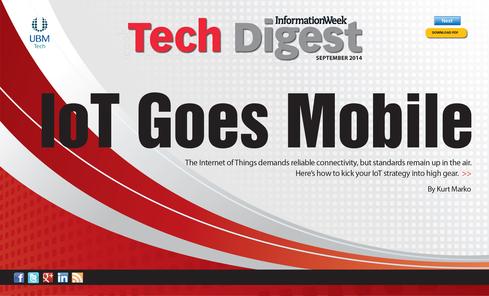Why The Industrial IoT Must Be Mobile
The Internet of Things demands reliable connectivity, yet standards are up in the air. Here's what that means for your strategy.

 Download the entire new issue of InformationWeek Tech Digest, distributed in an all-digital format (free registration required).
Download the entire new issue of InformationWeek Tech Digest, distributed in an all-digital format (free registration required).
Union Pacific CIO Lynden Tennison would love to place sensors on the company's railroad tracks that could warn if a switch is in the wrong position, possibly derailing a train. One reason this isn't feasible on all tracks today: inadequate communications links. How do you get a signal from a sensor in a remote area that's 100 miles from the nearest cell tower?
While consumers and Wall Street analysts tend to conflate "IoT" with "wearables tethered to smartphones," most enterprises don't consider mobile devices with 3G/LTE connectivity to be the most important -- or most common -- edge devices. There's a big difference between a fitness band tapping a health-tracking app and an industrial control system managing HVAC and building security cameras on a few dozen sites. While consumers eagerly await a svelte new iWatch or Android wearable, for organizations such as Union Pacific, FedEx, GE, and ConocoPhillips, the IoT is here, as we discussed in a recent cover story. These companies use IoT-enabled intelligent sensors, machine-to-machine connectivity, and sophisticated back-end data analysis to reap the business benefits of instrumenting, connecting, and analyzing data from equipment, vehicles, physical infrastructure, even people.
The first thing to keep in mind when mobilizing your IoT plan is the distinction between consumer and industrial. IoT consumer devices will likely either be tethered to a smartphone with a vast array of communications options and local storage and processing, or they will be used in controlled environments with access to WiFi and power, either a wall socket or easily replaceable or rechargeable batteries. The same can't be said for most industrial applications -- like pollution monitors affixed to traffic signs or water sensors in hard-to-access pipes, both of which run on a battery for months or years between servicing.
Big data expert and EMC CTO Bill Schmarzo defines the IoT bifurcation in a post on the company's blog:
--"The 'Industrial Internet' -- or machine-to-machine (M2M) communications -- describes machines, nodes, or devices that use network resources to communicate with a remote application infrastructure in order to monitor and control the machine or the surrounding environment. In other words, the Industrial Internet refers to all the devices, sensors, and software that enable connectivity among machines.
--"The Internet of Things or IoT can be thought of as the application layer of what the Industrial Internet will ultimately become."
The IoT is built on top of the Industrial Internet, Schmarzo says, leveraging the massive M2M data to enable the next generation of business applications.
Scale is another factor that differentiates IoT from conventional IT environments. Maciej Kranz, Cisco's VP of technology and overseer of the company's IoT vision, says the number of connected devices will increase from 12 billion to 50 billion this decade. But that's not the biggest disruption. The mix of devices will shift, from native IP clients such as PCs, tablets, and smartphones to IoT devices ranging from trucks and facilities equipment to assembly line machinery, train switches, even livestock.
That's right: WiFi-connected cattle are "things."
All this connectivity is causing the worlds of IT and OT (operational technology, the corporate groups responsible for production equipment and facilities) to merge. That's a good thing, Kranz says, because it lets each domain learn and incorporate best practices from the other. Much like the collision of data and telephony networks more than a decade ago, IT and OT now share the same technology space. In fact, it's a main reason Cisco is so interested in the IoT business -- it wants to apply its experience in, and technology for, building, securing, and managing large IP networks to new IoT infrastructure.
To read the rest of the story, get the new issue of
InformationWeek Tech Digest (free registration required).
About the Author(s)
You May Also Like
How to Amplify DevOps with DevSecOps
May 22, 2024Generative AI: Use Cases and Risks in 2024
May 29, 2024Smart Service Management
June 4, 2024







